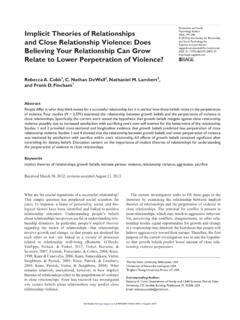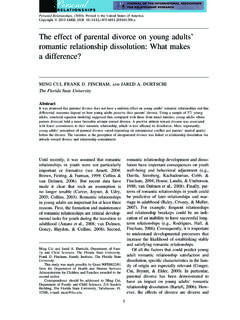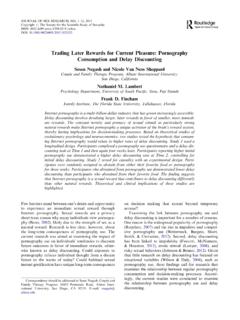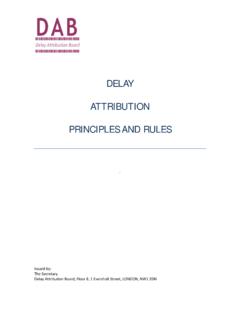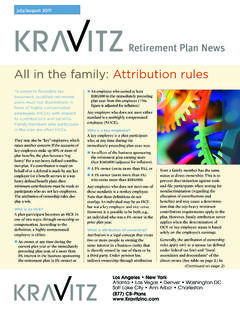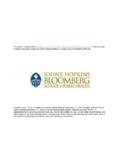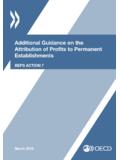Transcription of Children's Attributions in the Family: The Children's ...
1 Journal of Family Psychology Copyright 1998 by the American Psychological Association, Inc. 1998, Vol. 12, No. 4, 481-493 0893-3200/98/$ Children's Attributions in the Family: The Children's Relationship Attribution Measure Frank D. Fincham University of Wales, Cardiff Steven R. H. Beach, Ileana Arias, and Gene H. Brody University of Georgia This study assessed Children's Attributions in parent-child relationships, examined their association with relationship positivity and behavior displayed toward the parent, determined whether depressive symptoms account for these associations, and investigated whether parent and child Attributions are linked. Ten- to 12-year- old children (116 girls, 116 boys) completed several questionnaires and were observed during parent-child interactions. Children's Attributions for parent behav- ior were related to positivity of the parent-child relationship and to self- and parent-reported conflict and observed behavior with the father.
2 These associations were not due to Children's depressive symptoms but potentially augment our understanding of the effect of depression on parent-child relationships. Finally, gender moderated the parent attribution-child attribution association. The results underscore the importance of Children's perceptions of family processes. The study of Children's perceptions of family events has led to increased understanding of their reactions to such events at both theoretical ( , Davies & Cummings, 1994; Grych & Fincham, 1990) and empirical levels ( , Grych, Seid, & Fincham, 1992; Kurdek & Berg, 1987; Mazur, Wolchik, & Sandier, 1992). Although Children's Attributions or explanations for events predict their functioning in several Frank D. Fincham, School of Psychology, Univer- sity of Wales, Cardiff, Great Britain; Steven R. H. Beach and Ileana Arias, Department of Psychology, University of Georgia; Gene H. Brody, Department of Child and Family Development, University of Georgi~ This study was supported by National Institute on Alcohol Abuse and Alcoholism Grant AA09224, by a grant from the Economic and Social Research Council, and by a Social Science Research Fellow- ship from the Nuffield Foundation awarded to Frank D.
3 Fincham. Correspondence concerning this article should be addressed to Frank D. Fincham, School of Psychol- ogy, Box 901, University of Wales, Cardiff, Cardiff CF1 3YG Great Britain or to Gene H. Brody, Department of Child and Family Development, Dawson Hall, University of Georgia, Athens, Georgia 30602. Electronic mail may be sent to Frank D. Fincham at or to Gene H. Brody at gbrody domains ( , reactions to peer behavior, Crick & Dodge, 1994; manifestation of depressive symptoms, Gladstone & Kaslow, 1995), a body of knowledge has not yet emerged on Children's Attributions in family relationships. This omis- sion is further underscored by numerous studies on adults' Attributions for relationship events that have advanced understanding of marriage (see Fincham, 1994) and parent-child relation- ships (see Miller, 1995). The present study, therefore, focused on Children's Attributions in the context of the parent--child relationship and investigated theoretically predicted associations with the positivity of the parent-child relation- ship and with reported and observed behavior.
4 In doing so, it tested whether the hypothesized correlates of Children's Attributions are an artifact of depressive symptoms. Finally, it examined the relationship between parental and child Attributions . At a theoretical level, it can be hypothesized that Attributions are important for understanding Children's relationships to their parents for two main reasons. First, in developing attribution theory, Heider (1958) argued that the nature of the Attributions a person makes should be related to whether the person likes the attribution target. This hypothesized link between Attributions and relationship positivity has led to the hypothesis 481 482 FINCHAM, BEACH, ARIAS, AND BRODY that Attributions can change, maintain the quality of the relationship between the attributor and the attribution target, or both. Second, Heider noted that the attribution made for a person's behavior is likely to influence the attributor's behavior toward the attribution target.
5 In research on close relationships, this factor has led to the hypothesis that Attributions made for an intimate's behavior will be related to behavior shown in interactions with him or her. There is evidence from studies of adults to support each of these hypotheses for negative relationship events ( , the events that prompt attribution processing, Weiner, 1985). First, Attributions for spouse behavior are related to current marital satisfaction and predict future marital satisfaction ( , Fincham & Bradbury, 1991; Fincham, Bradbury, Arias, Byrne, & Karney, 1997). Second, Attributions are related to observed behavior during laboratory interac- tions ( , Bradbury, Beach, Fincham, & Nelson, 1996; Bradbury & Fincham, 1992; for reviews, see Bradbury & Fincham, 1990; Fincham, 1998). In particular, Attributions for negative behavior that show certain features (infer the behavior is intentional, selfishly motivated, and blameworthy; locate the cause of the behavior in the partner; and view the cause as global and stable) accentuate the impact of negative partner behavior.
6 Such Attributions can be characterized as conflict-promoting attribu- tions and are associated with relatively more negative behavior toward the partner. Accord- ingly, in adulthood, Attributions are related in important ways to relationship satisfaction and behavior. Is there similar evidence linking Children's Attributions to their behavior and the nature of their relationships? As regards child behavior, there is evidence to show that the tendency to infer hostile intent for hypothetical, ambiguous peer behaviors predicts retaliatory aggressive responses, later acts of aggression, and teacher ratings of reactive aggression ( , Crick & Dodge, 1996; Dodge, Bates, & Pettit, 1990). However, assessment of Children's Attributions in this domain has examined only hostile intent. A limitation of this assessment is that it focuses on one of several possible dimensions of responsibility Attributions (which concern ac- countability for an event) relevant to understand- ing interpersonal behavior and does not assess dimensions underlying causal Attributions (which concern who or what produced an event; see Fincham & Jaspars, 1980; Shaver, 1985).
7 As regards Children's relationships, Cook (1993) developed a multidimensional measure of locus of control with college students and extended its use to other family members, including siblings of 12 years or older. He found that beliefs about interpersonal control in the family reflected characteristics of the family member to whom the beliefs pertained, the relationship with the family member, and the characteristics of the perceiver. This study emphasizes the need to study Children's Attributions for each parent separately, but again, the data pertain to a single attribution dimension (locus). In contrast, the attribution measures used in research on Children's depressive symptoms, the Children's Attribution Styles Questionnaire (CASQ; Seligman et al., 1984) and CASQ--- Revised (Kaslow & Nolen-Hoeksema, 1991), assess three dimensions underlying causal attri- butions (locus, stability, and globality). Meta- analyses show that internal, stable, and global Attributions for negative events and external, unstable, and specific Attributions for positive events are associated with concurrent depressive symptoms and that a combined index for positive and negative events predicts future depressive symptoms (Gladstone & Kaslow, 1995; Joiner & Wagner, 1995).
8 Although the original and revised CASQs include Attributions for interpersonal events, these Attributions tend not to be analyzed independently of Attributions for achievement events (for an exception, see Turner & Cole, 1994). Moreover, even if interpersonal events were analyzed separately, they would provide information only about Attributions the child makes for his or her own interpersonal behavior rather than the behavior of a significant other. Thus, there is evidence that by early adolescence Attributions are consequential for affective reactions and for some aspects of interpersonal behavior. How- ever, evidence regarding the role of child and adolescent Attributions in family relationships is scant. In view of these observations, there is a need for the development of an attribution measure that assesses multiple dimensions of Children's Attributions in interpersonal contexts, particu- larly the family. This task can be facilitated by drawing on marital attribution research.
9 Utiliz- Children's ATrRIBUTIONS IN THE FAMILY 483 ing this resource yields three important advan- tages. First, marital researchers have identified the responsibility attribution dimensions (in- ferred intent, motivation, blame) and causal attribution dimensions (locus, stability, global- ity) that are useful for understanding relation- ships. Second, use of marital attribution assess- ment procedures could result in analogous attribution measures in marital and parent--child relationships. Third, the marital literature pro- vides a theoretical analysis of Attributions in close relationships (see Bradbury & Fincham, 1990) that can be used to establish the validity of a child attribution measure and to inform research on children. It is therefore perhaps not surprising that Grace, Kelley, and McCain (1993) adapted a marital attribution measure, the Marital Attribu- tion Style Questionnaire (Fincham, Beach, & Nelson, 1987), to show that adolescents' conflict- promoting Attributions for maternal behaviors were positively related to reported conflict between mother and child.
10 However, this adaptation is limited in several ways. First, little attention was given to establishing the psycho- metric properties of the measure. Second, fathers were not studied, and there is growing empirical evidence that findings pertaining to mother--child relations cannot be generalized to father--child relations ( , Osborne & Fin- cham, 1996; Phares & Compas, 1992). Third, the results are not examined in relation to child gender. Fourth, only self-report measures of behavior were used, thereby providing limited data on which to evaluate the validity of the measure. Finally, except for the target events for which Attributions were made, the format of the attribution assessment was identical to that used in an early marital attribution measure, which is important because limitations of the measure led to its revision. Specifically, the format of the measure was changed to make the attribution assessment simpler and to avoid ambiguities in interpretation of responses (see Fincham & Bradbury, 1992).


